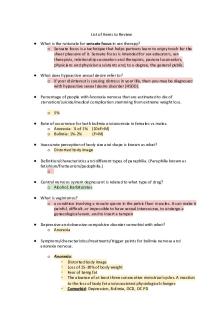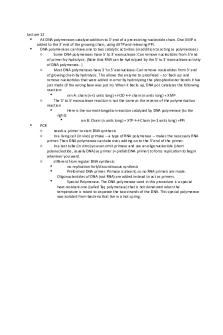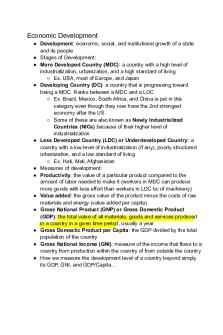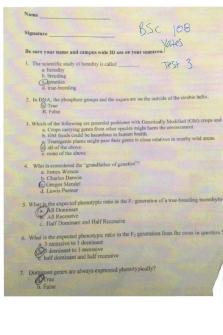MCBL Test 3 - Review for test 3 PDF

| Title | MCBL Test 3 - Review for test 3 |
|---|---|
| Course | Microbiology Laboratory |
| Institution | Miami Dade College |
| Pages | 6 |
| File Size | 247.5 KB |
| File Type | |
| Total Downloads | 115 |
| Total Views | 149 |
Summary
Review for test 3 based on microbes and microscope. ...
Description
MCB 2010L Test 3 – Review Cultural Characteristics Ex 2-2: Colony morphology 1. Define colony - A visible mass of cells. 2. What are the factors influencing colony morphology? - Colony, size, shape, and texture. 3. What are basic categories of colony morphology? - Colony shape, margin (edge), elevation, texture, and pigment production (color). 4. How are each category described? a. Shape: round, irregular, or punctiform (tiny) b. Margin: smooth, wavy, lobed, filamentous, or rhizoid (branched like roots) c. Elevations: flat, raised d. Texture: moist, mucoid, dry e. Pigment production (color): opaque, translucent, shiny, or dull
Ex: 2-3, 2-4: Growth Pattens on Slants and Broth 1. Describe the growth patterns seen on slants. - Filiform: dense and opaque - Friable: crusty - Spreading edge: solid growth seeming to radiate forward - Translucent: transparent 2. Identify growth pattern when shown.
(filiform, spreading edge, friable, transparent) 3. Describe growth pattern seen in Broth. - Pellicle: organisms float at the top - Sediment: organism sinks to the bottom - Uniform fine turbidity: some bacteria is produced - Flocculent: appear in clumps
4. Identify it when shown.
Ex 2-7: Oxygen Requirement –Fluid Thioglycollate Medium 1. What is the medium used for finding the oxygen requirement of your organism? - Fluid Thioglycollate Medium is a liquid medium designed to promote growth of a wide variety of fastidious microorganisms. 2. What are the key ingredients in the medium and what does each one do? - Key ingredients are yeast extract, pancreatic digest of casein, dextrose, sodium thioglycollate, L-cystine, and reazurin. - Yeast extract and pancreatic digest: provide nutrients - Sodium thioglycollate and L-cystine: reduce oxygem to H2O - Reazurin: indicator 3. What are the different categories of organisms based on oxygen requirement? - Aerobic, anaerobic, fastidious, and nonfastidious. 4. Be able to classify organism based on growth in FTM - Page 51.
Physiological (Biochemical) Characteristics: General Information Pages 129-131, 149-151 Define selective media, differential media.
Selective media: enhances the isolation procedure by inhibiting the growth of some organisms while encouraging the growth of others. Differential media: selective media that contains indicators to expose differences between organisms.
What are indicators in biochemical tests? Give examples - Frequently a dye that changes color as pH changes. Example: ferric sulfate
What are the three principal products of microbial fermentation? - Organic acids, alcohols, hydrogen or carbon dioxide gas.
What is the difference between aerobic and anaerobic respiration? - Aerobic is s type of energy releasing metabolism in which oxygen is the final electron acceptor and in anaerobic the final electron acceptor is an inorganic compound other than oxygen.
Ex:5-3 Phenol Red Broth
What are the sugars tested using this media? - Glucose, lactose, and sucrose
What is the purpose of growing the unknown in this media? - To differentiate members of Enterobactriaceae and to distinguish them from other Gram-negative rods.
What is the indicator used in this media? - Phenol red
What is the purpose of adding Durham tubes in the media? - Indicator of gas production.
How does the tube turn yellow when sugar in media fermented? - The acid production lowers the pH below the neutral range of the indicator and turns the medium yellow.
Is peptone a sugar? How does peptone degradation change PR media to pink? - Peptone is not a sugar. Deamination of peptone amino acids produces ammonia which raises the pH and turns the broth pink.
Ex 5-4: MR-VP tests What are the ingredients in MR-VP broth? - Peptone, glucose, and a phosphate buffer.
What is the sugar in MR-VP broth? - Glucose.
Differentiate between mixed acid fermentation and Butanediol fermentation. - Mixed acid fermentation (tested by MR) overcomes the phosphate buffer in the medium and lowers the pH and Butanediol (tested by VP) identifies bacteria able to produce acetoin.
How do you determine mixed acid fermentation? - It is verified by the addition of methyl red indicator dye following incubation. Methyl red is red at a pH 4.4 and yellow at a pH 6.2.
What are the reagents used for VP tests (Chemical names)? What would be the appearance of a positive result? - Reagent A and reagent B. - A positive test is red in 60 minutes.
Ex 5-5, Catalase Test What is the purpose of catalase test? What is the function of catalase? What is the reagent used for catalase test? How does bubbles form in a positive catalase test? Ex 5-6: Oxidase Test What is the purpose for oxidase test? What is the function of oxidase? What do we use for oxidase test? What is the expected result of a positive test for oxidase? Ex 5-7:Nitrate Reduction Test
What is the role of nitrate in this medium? What are possible products of nitrate reduction? What are the reagents used for nitrate reduction test (chemical names)? Which of nitrate reduction product is detected by the reagents added? What is the enzyme needed for nitrate reduction? What is denitrification? What is the appearance of a positive nitrate reduction test? Why do you need to do the zinc test to confirm a negative test in nitrate reduction?
EX5-13, 5-15, 5-16, 5-17, 5-19: Hydrolytic reactions 1. What is hydrolysis? 2. What is the difference between intracellular and extracellular(exo) enzymes? 3. For the following tests, list the media used, enzymes involved, products of hydrolysis, appearance of positive and negative tests, interpretation of results, reagents used (if any) . Starch hydrolysis, Casein hydrolysis Fat hydrolysis
Gelatin hydrolysis Urea hydrolysis
Ex 5-8: Citrate Utilization Test What is the purpose of this test? What is the media used for this test? What are the key ingredients in this media? What is the role of Bromthymol blue in the media? Which enzyme is needed to transport citrate into the cell? Why do have to use ‘needle’ not the loop to inoculate for this test? How do differentiate between positive and negative results for this test? What does a positive result indicate about your bacteria? What are IMViC tests? Which bacteria can be confirmed by these tests Ex 5-11: Phenylalanine Deaminase Test What is deamination? What are the products of phenylalanine deamination? What is the reagent used for this test? Which product of deamination combines with the reagent to make the green color for a positive test? Which genera of bacteria can be differentiated with this test? EX 5-20: SIM Medium List the three bacterial activities that can be tested using this medium? Which amino acid in the medium is key to test sulfur reduction using this medium? What is the product of sulfur reduction? How does the black color, indicative of sulfur reduction, develop in the medium? Which amino acid is key to detect indole production? What is the reagent used for testing indole production? How do you recognize positive results for Sulfur reduction, Indole and motility? Ex 5-30: Enterotube II When do we use enterotube? How many media used in this tube? How many tests are done? Which test on Enterotube II is used only for confirmation? How do you determine your unknown based on the Enterotube results? Ex 7-5: Morbidity and Mortality Report What is epidemiology? What are the important disease measures epidemiologists collect? Define Morbidity, Mortality, and Incidence. How do you calculate incidence rate? How does the epidemiological data help health care providers? Ex 10-7:Phage Typing
What is a bacteriophage? What is the purpose of phage typing? How does the clearing zone formed in phage typing? What are the information included in classical identification methods used in microbiology?...
Similar Free PDFs

MCBL Test 3 - Review for test 3
- 6 Pages

TEST 3 - test 3 review
- 19 Pages

Abnormal Review for Test #3
- 6 Pages

Test 3 Review
- 2 Pages

Test 3 - Review
- 2 Pages

Test 3 Review
- 8 Pages

Review Test 3
- 2 Pages

MPO Test 3 Review
- 9 Pages

Test 3 Review Questions
- 7 Pages

Lecture notes - Review for test 3
- 16 Pages

IBF Test 3 - Test 3
- 1 Pages

Test 3 review - Prof. Mowsh
- 15 Pages

Human geography test 3 review
- 10 Pages

Unit 3 Psychology Test Review
- 5 Pages

Philosphy 150 test review 3
- 3 Pages

Yates Test 3 - Test
- 7 Pages
Popular Institutions
- Tinajero National High School - Annex
- Politeknik Caltex Riau
- Yokohama City University
- SGT University
- University of Al-Qadisiyah
- Divine Word College of Vigan
- Techniek College Rotterdam
- Universidade de Santiago
- Universiti Teknologi MARA Cawangan Johor Kampus Pasir Gudang
- Poltekkes Kemenkes Yogyakarta
- Baguio City National High School
- Colegio san marcos
- preparatoria uno
- Centro de Bachillerato Tecnológico Industrial y de Servicios No. 107
- Dalian Maritime University
- Quang Trung Secondary School
- Colegio Tecnológico en Informática
- Corporación Regional de Educación Superior
- Grupo CEDVA
- Dar Al Uloom University
- Centro de Estudios Preuniversitarios de la Universidad Nacional de Ingeniería
- 上智大学
- Aakash International School, Nuna Majara
- San Felipe Neri Catholic School
- Kang Chiao International School - New Taipei City
- Misamis Occidental National High School
- Institución Educativa Escuela Normal Juan Ladrilleros
- Kolehiyo ng Pantukan
- Batanes State College
- Instituto Continental
- Sekolah Menengah Kejuruan Kesehatan Kaltara (Tarakan)
- Colegio de La Inmaculada Concepcion - Cebu